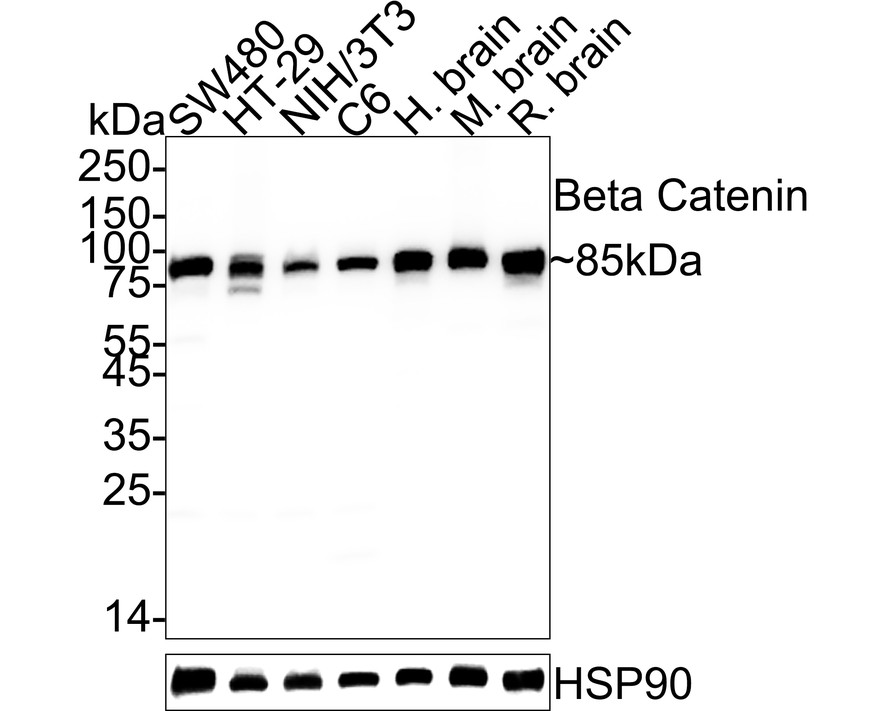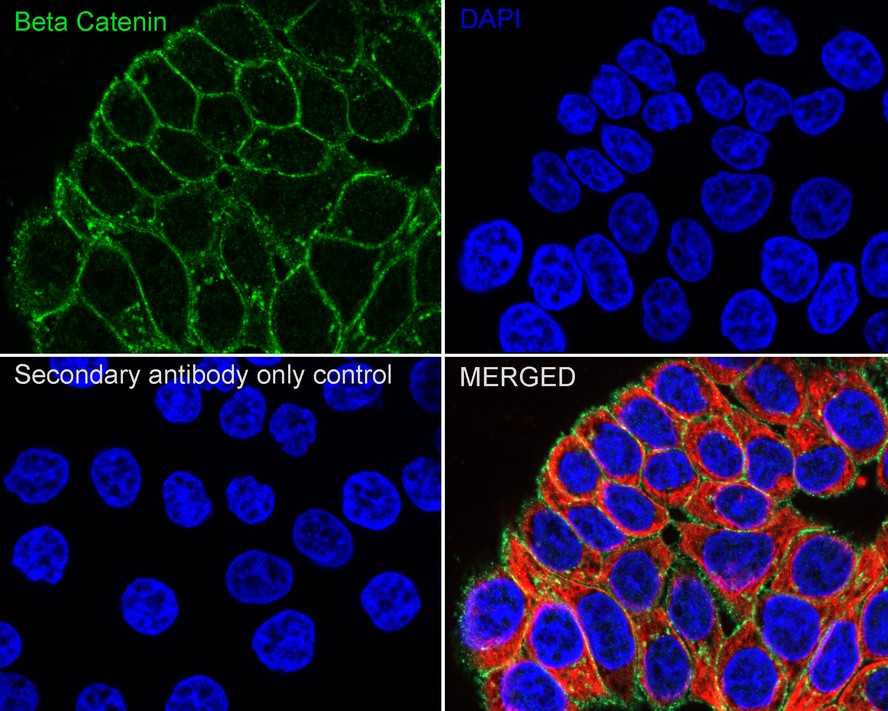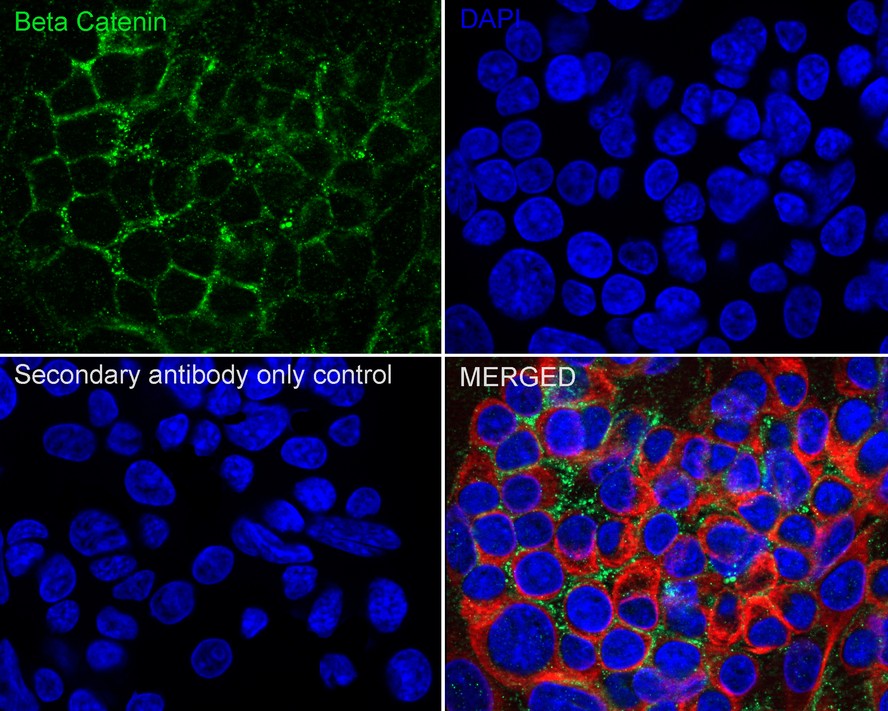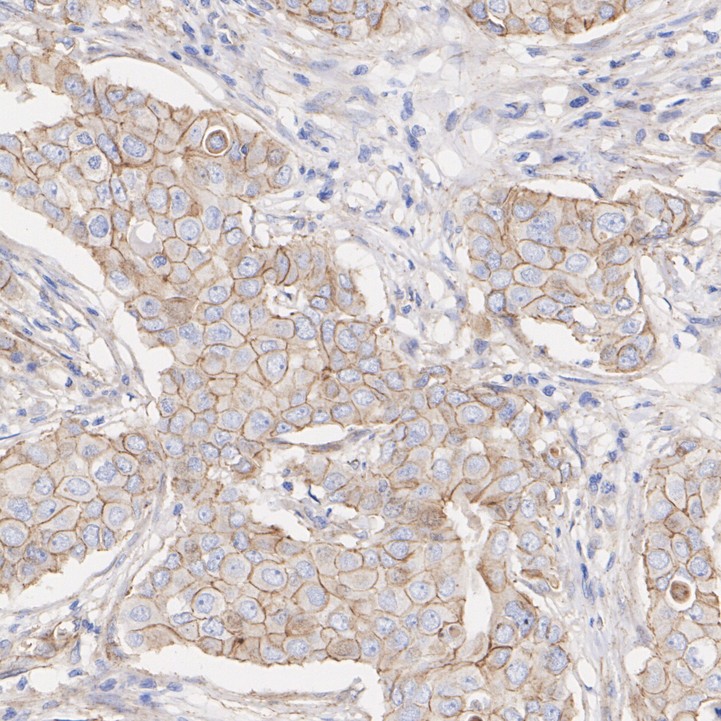Beta Catenin Rabbit Polyclonal Antibody

cat.: ER0805
| Product Type: | Rabbit polyclonal IgG, primary antibodies |
|---|---|
| Species reactivity: | Human, Mouse, Rat |
| Applications: | WB, IHC-P, FC, IF-Cell, IF-Tissue |
| Clonality: | Polyclonal |
| Form: | Liquid |
| Storage condition: | Shipped at 4℃. Store at +4℃ short term (1-2 weeks). It is recommended to aliquot into single-use upon delivery. Store at -20℃ long term. |
| Storage buffer: | 1*PBS (pH7.4), 0.2% BSA, 40% Glycerol. Preservative: 0.05% Sodium Azide. |
| Concentration: | 1ug/ul |
| Purification: | Immunogen affinity purified. |
| Molecular weight: | Predicted band size: 85 kDa |
| Isotype: | IgG |
| Immunogen: | Synthetic peptide within C-terminal human Beta-Catenin. |
| Positive control: | SW480 cell lysate, HT-29 cell lysate, NIH/3T3 cell lysate, C6 cell lysate, Human brain tissue lysate, Mouse brain tissue lysate, Rat brain tissue lysate, HT-29, C6, human breast cancer tissue, human colon cancer tissue, mouse colon tissue, rat colon tissue. |
| Subcellular location: | Cytoplasm, Nucleus, Cell junction, Cell membrane, Cytoskeleton, Synapse. |
| Recommended Dilutions:
WB IHC-P FC IF-Cell IF-Tissue |
1:1,000 1:5,000 1:1,000 1:100-1:500 1:200-1:1,000 |
| Uniprot #: | SwissProt: P35222 Human | Q02248 Mouse | Q9WU82 Rat |
| Alternative names: | β Catenin Beta catenin Beta-catenin Cadherin associated protein Catenin (cadherin associated protein), beta 1, 88kDa Catenin beta 1 Catenin beta-1 CATNB CHBCAT CTNB1_HUMAN CTNNB CTNNB1 DKFZp686D02253 FLJ25606 FLJ37923 OTTHUMP00000162082 OTTHUMP00000165222 OTTHUMP00000165223 OTTHUMP00000209288 OTTHUMP00000209289 |
Images

|
Fig1:
Western blot analysis of Beta Catenin on different lysates with Rabbit anti-Beta Catenin antibody (ER0805) at 1/1,000 dilution. Lane 1: SW480 cell lysate (20 µg/Lane) Lane 2: HT-29 cell lysate (20 µg/Lane) Lane 3: NIH/3T3 cell lysate (20 µg/Lane) Lane 4: C6 cell lysate (20 µg/Lane) Lane 5: Human brain tissue lysate (40 µg/Lane) Lane 6: Mouse brain tissue lysate (40 µg/Lane) Lane 7: Rat brain tissue lysate (40 µg/Lane) Predicted band size: 85 kDa Observed band size: 85 kDa Exposure time: 4 seconds; ECL: K1801; 4-20% SDS-PAGE gel. Proteins were transferred to a PVDF membrane and blocked with 5% NFDM/TBST for 1 hour at room temperature. The primary antibody (ER0805) at 1/1,000 dilution was used in 5% NFDM/TBST at 4℃ overnight. Goat Anti-Rabbit IgG - HRP Secondary Antibody (HA1001) at 1/50,000 dilution was used for 1 hour at room temperature. |

|
Fig2:
Immunocytochemistry analysis of HT-29 cells labeling Beta Catenin with Rabbit anti-Beta Catenin antibody (ER0805) at 1/100 dilution. Cells were fixed in 4% paraformaldehyde for 20 minutes at room temperature, permeabilized with 0.1% Triton X-100 in PBS for 5 minutes at room temperature, then blocked with 1% BSA in 10% negative goat serum for 1 hour at room temperature. Cells were then incubated with Rabbit anti-Beta Catenin antibody (ER0805) at 1/100 dilution in 1% BSA in PBST overnight at 4 ℃. Goat Anti-Rabbit IgG H&L (iFluor™ 488, HA1121) was used as the secondary antibody at 1/1,000 dilution. PBS instead of the primary antibody was used as the secondary antibody only control. Nuclear DNA was labelled in blue with DAPI. Beta tubulin (M1305-2, red) was stained at 1/100 dilution overnight at +4℃. Goat Anti-Mouse IgG H&L (iFluor™ 594, HA1126) was used as the secondary antibody at 1/1,000 dilution. |

|
Fig3:
Immunocytochemistry analysis of C6 cells labeling Beta Catenin with Rabbit anti-Beta Catenin antibody (ER0805) at 1/500 dilution. Cells were fixed in 4% paraformaldehyde for 20 minutes at room temperature, permeabilized with 0.1% Triton X-100 in PBS for 5 minutes at room temperature, then blocked with 1% BSA in 10% negative goat serum for 1 hour at room temperature. Cells were then incubated with Rabbit anti-Beta Catenin antibody (ER0805) at 1/500 dilution in 1% BSA in PBST overnight at 4 ℃. Goat Anti-Rabbit IgG H&L (iFluor™ 488, HA1121) was used as the secondary antibody at 1/1,000 dilution. PBS instead of the primary antibody was used as the secondary antibody only control. Nuclear DNA was labelled in blue with DAPI. Beta tubulin (M1305-2, red) was stained at 1/100 dilution overnight at +4℃. Goat Anti-Mouse IgG H&L (iFluor™ 594, HA1126) was used as the secondary antibody at 1/1,000 dilution. |

|
Fig4:
Immunohistochemical analysis of paraffin-embedded human breast cancer tissue with Rabbit anti-Beta Catenin antibody (ER0805) at 1/5,000 dilution. The section was pre-treated using heat mediated antigen retrieval with Tris-EDTA buffer (pH 9.0) for 20 minutes. The tissues were blocked in 1% BSA for 20 minutes at room temperature, washed with ddH2O and PBS, and then probed with the primary antibody (ER0805) at 1/5,000 dilution for 1 hour at room temperature. The detection was performed using an HRP conjugated compact polymer system. DAB was used as the chromogen. Tissues were counterstained with hematoxylin and mounted with DPX. |

|
Fig5:
Immunohistochemical analysis of paraffin-embedded human colon cancer tissue with Rabbit anti-Beta Catenin antibody (ER0805) at 1/5,000 dilution. The section was pre-treated using heat mediated antigen retrieval with Tris-EDTA buffer (pH 9.0) for 20 minutes. The tissues were blocked in 1% BSA for 20 minutes at room temperature, washed with ddH2O and PBS, and then probed with the primary antibody (ER0805) at 1/5,000 dilution for 1 hour at room temperature. The detection was performed using an HRP conjugated compact polymer system. DAB was used as the chromogen. Tissues were counterstained with hematoxylin and mounted with DPX. |

|
Fig6:
Immunohistochemical analysis of paraffin-embedded mouse colon tissue with Rabbit anti-Beta Catenin antibody (ER0805) at 1/5,000 dilution. The section was pre-treated using heat mediated antigen retrieval with Tris-EDTA buffer (pH 9.0) for 20 minutes. The tissues were blocked in 1% BSA for 20 minutes at room temperature, washed with ddH2O and PBS, and then probed with the primary antibody (ER0805) at 1/5,000 dilution for 1 hour at room temperature. The detection was performed using an HRP conjugated compact polymer system. DAB was used as the chromogen. Tissues were counterstained with hematoxylin and mounted with DPX. |

|
Fig7:
Immunohistochemical analysis of paraffin-embedded rat colon tissue with Rabbit anti-Beta Catenin antibody (ER0805) at 1/5,000 dilution. The section was pre-treated using heat mediated antigen retrieval with Tris-EDTA buffer (pH 9.0) for 20 minutes. The tissues were blocked in 1% BSA for 20 minutes at room temperature, washed with ddH2O and PBS, and then probed with the primary antibody (ER0805) at 1/5,000 dilution for 1 hour at room temperature. The detection was performed using an HRP conjugated compact polymer system. DAB was used as the chromogen. Tissues were counterstained with hematoxylin and mounted with DPX. |

|
Fig8:
Flow cytometric analysis of HT-29 cells labeling Beta Catenin. Cells were fixed and permeabilized. Then stained with the primary antibody (ER0805, 1/1,000) (red) compared with Rabbit IgG Isotype Control (green). After incubation of the primary antibody at +4℃ for an hour, the cells were stained with a iFluor™ 488 conjugate-Goat anti-Rabbit IgG Secondary antibody (HA1121) at 1/1,000 dilution for 30 minutes at +4℃. Unlabelled sample was used as a control (cells without incubation with primary antibody; black). |
Note: All products are “FOR RESEARCH USE ONLY AND ARE NOT INTENDED FOR DIAGNOSTIC OR THERAPEUTIC USE”.